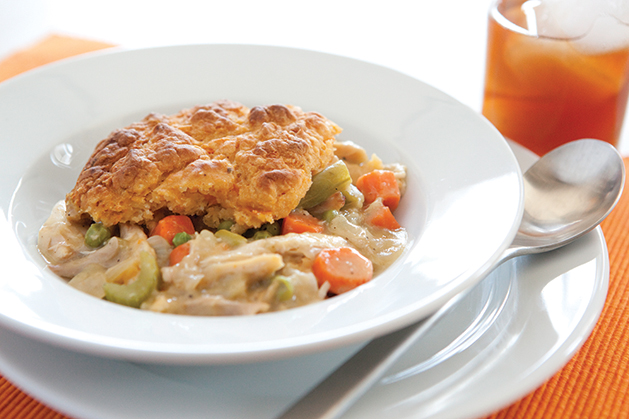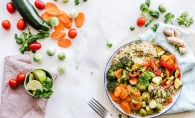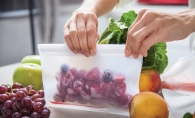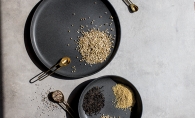
Somewhere, someone in your family or friend circle (or maybe it’s you!) is planning this year’s Thanksgiving meal. This annual celebratory feast serves as an expression of gratitude and helps us connect or reconnect with loved ones around a bountiful table of nostalgia-inducing dishes—the center of which is typically turkey.
It’s unsurprising that turkey is tops on American tables since the U.S. produces the most turkeys of any country in the world, followed by Brazil and Germany. Americans consume approximately 46 million turkeys around Thanksgiving and consumed around five billion pounds of turkey in 2019. That’s 16 pounds per person that year!
Come closer to home and you’ll discover that Minnesota has the largest number of independent turkey farmers in the nation with over 600 turkey farms and stakeholders, making Minnesota the turkey capital of the U.S. According to the Minnesota Turkey Growers Association (MTGA), Minnesota turkey farmers raise between 40 and 42 million birds every year, and the industry generates over $1 billion in economic activity and provides more than 26,000 jobs in the state.
The association’s executive director Sarah Anderson says of the 600 turkey farms in Minnesota, “Some are multi-generational families. One farmer is a sixth generation turkey grower. Imagine that, growing turkeys since the civil war era. Most are family operations with farmers who live with their flocks. This is not a hobby for them but their livelihood,” and so they’re dedicated to delivering high quality.
Quality continues with Minnesota’s three locally-owned operators who bring the turkeys from farm to table. According to the MTGA’s website, “Jennie-O Turkey Store based in Willmar, Minn., allows consumers to trace their whole turkey back to the farm. Turkey Valley Farms is a grower-owned operation in Marshall, Minn., and is known for packaging as many as 100 private labels, as well as antibiotic-free and free-range birds, and Northern Pride in Thief River Falls, Minn., is a cooperative of independent turkey farmers who, among other products, specialize in free-range, antibiotic-free and organic turkeys.”
Anderson points out that there is U.S. Department of Agriculture (USDA) presence at each processing facility to ensure standards are met. (This monitoring could also be done by the state government so long as the consistent, stringent guidelines are met.) Did you know that it’s illegal to raise turkeys with added hormones?
For those who prefer to shop organic, Anderson says, “There are federal government USDA guidelines for organic certification for poultry, and no farmer can just slap an ‘organic’ label on their product. When it comes to organic, feed is the big thing. Also, no hormones or steroids. No antibiotics is another big thing [for organic certification], although many farmers provide that.”
Want to go beyond organic and purchase a free-range turkey? According to Jayson Lusk, department head and distinguished professor of agricultural economics at Purdue University, all turkeys are raised cage free, mostly in large open barns. But free-range turkey farming is also practiced in Minnesota. Anderson says, “You can take a fun trip with the family on a Saturday before Thanksgiving to visit a grower called Ferndale Market in Cannon Falls and pick out your own free-range turkey, not unlike picking out your Christmas tree. Several processors also specialize in free-range, antibiotic-free turkeys. Most anything you prefer is available, and grocery labels should [indicate what you’re getting] since it is regulated by the government.”
Anderson also shared that some grocers provide turkeys labeled with a QR code that lets consumers track which farm raised that particular bird. The QR code can also provide a bio about the farm family for a peek into who cared for that bird. “Some folks from the East Coast contacted us about a bird they got from Minnesota,” Anderson says. “This is so great because it brings home the fact that the food you eat came from a farm and that your purchase is supporting a family farm.”
We asked Allison Thomas, Whole Foods Market’s culinary standards manager, for some shopping and cooking tips.
How many pounds of turkey per person? When reserving or selecting a whole turkey, allow at least 1 pound per person, plus an extra 1/2 pound per person if you want leftovers (this includes bones).
What is the best way to thaw a frozen turkey? Most reliable way: Put a tray or pan underneath the bird in its packaging to catch drips, and place it in the refrigerator on the lowest shelf for one full day for every five pounds of turkey. Fastest way: Make sure the turkey is sealed in a leak-proof wrapper, and place it in a vessel large enough to completely contain it. Add cold tap water to cover. Change the water every 30 minutes, and allow 30 minutes of thawing time per pound.
How can cooks make sure stuffing from the turkey is safe to eat? … Because turkey juice drips into the stuffing while roasting, the stuffing needs to reach the same temperature as the fully-cooked turkey (165 degrees F) in order to be safe to eat. The stuffing will be the last area to come to proper temperature, so more than likely the breast meat will be overcooked and dry by the time the stuffing is safe to eat. If your turkey is done but the stuffing isn’t, consider transferring the stuffing to a baking dish and putting it back into the oven until it comes to 165 degrees F. Microwaving until it reaches 165 degrees F is also an option. Remember to loosely spoon the stuffing into the cavity—do not compact it. You want heat to circulate throughout.
How long should a turkey rest? While it depends on the recipe you’re using, most recommend letting the turkey rest anywhere between 30 and 40 minutes before starting to carve and serve.
Dinner is Served … Again
If you plan it right, you’ll have some solid turkey leftovers, but let’s forget about serving up the same ol’ same ol’ cold turkey sandwiches with mayo or Miracle Whip, depending on which condiments camp you reside.
Switch it up with some recommened recipes from Thomas.
Thai-Style Red Curry with Turkey and Green Beans
- 1 Tbsp. canola oil
- 1 red onion, cut into 1 1/2-inch chunks
- 2 Tbsp. red curry paste
- 13.5 oz. light coconut milk
- 1 1/2 cup low-sodium chicken broth
- 3 cups shredded roasted turkey breast (about 1 1/4 pounds)
- 6 carrots, chopped
- 16 oz. package frozen haricots verts
- 1 Tbsp. lime juice
Heat oil in a large pot over medium high heat. Add onion and cook, stirring often, until deep golden brown, about 5 minutes. Stir in curry paste, and cook for 1 minute more. Whisk in coconut milk and broth, add turkey and carrots, and bring to a boil. Reduce heat to medium low, cover and simmer until carrots are almost tender, 7 to 8 minutes. Uncover, stir in green beans and lime juice, and cook until carrots are tender and curry is thickened and hot throughout, 6 to 8 minutes more.

Turkey Noodle Soup
What better way to use leftover turkey from Thanksgiving than to make a satisfying pot of turkey noodle soup? Our hearty version gets a nutritional boost from kale and whole wheat elbow macaroni.
- 1 medium yellow onion, chopped
- 2 carrots, chopped
- 2 stalks celery, thinly sliced
- 2 cloves garlic, finely chopped
- 4 cups low-sodium chicken broth or homemade turkey broth
- 4 sprigs fresh thyme
- 1 bunch kale, thick stems removed and leaves thinly sliced
- 2 cups whole wheat elbow macaroni
- 2 cups (10 oz.) cooked turkey breast, cubed or shredded
Heat a large saucepan over medium-high heat until hot. Add onion, carrots, celery and garlic and cook, stirring occasionally, until vegetables are tender and beginning to brown, 6 to 7 minutes. Stir in broth, 4 cups water and thyme, and bring to a boil. Add kale and macaroni; return to a boil. Cook about 5 minutes or until macaroni is al dente. Stir in turkey and pepper, and cook 2 to 3 minutes longer or until turkey is heated through. Remove thyme sprigs before serving.

Turkey with Sweet Potato Dumplings
For leftover vegetables, choose green beans, carrots, peas, broccoli or others that were cooked simply with few other ingredients. You can cook a turkey breast for this if you don’t have any leftovers on hand.
- 1 small yellow onion, chopped
- salt and ground black pepper, to taste
- 4 cups raw, cooked or frozen chopped vegetables
- 1 1/2 cup all-purpose flour, divided
- 2 cups low-sodium chicken broth
- 3 cups cooked turkey, shredded
- 1 cup mashed sweet potatoes (or a 3/4-pound sweet potato, cooked and mashed)
- 2 tsp. baking soda
- 1 1/2 cup buttermilk
Preheat the oven to 400°F. Heat oil in a large skillet over medium high heat. Add onions, salt and pepper and cook, stirring occasionally, until golden, 8 to 10 minutes. Add vegetables, and cook until softened and hot throughout, whether you use raw, cooked or frozen veggies. Sprinkle 1/4 cup flour over vegetables, stir well and cook 2 minutes. Whisk in broth, bring to a boil and then reduce heat to medium low, and simmer until thickened, 2 to 3 minutes. Stir in turkey, salt and pepper; transfer to a 9-x13-inch baking dish; set aside. In a large bowl, gently combine 1 1/4 cups flour, sweet potatoes, baking soda, buttermilk, 1/2 teaspoon salt and 1/4 teaspoon pepper to make a thick batter. Do not over mix. Drop batter in large spoonsful over turkey mixture to form 8 dumplings. Bake until dumplings are golden brown and cooked through, about 30 minutes.









